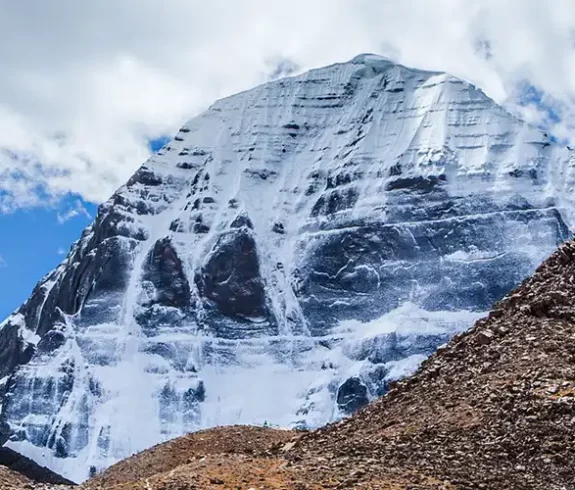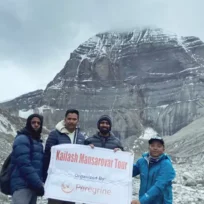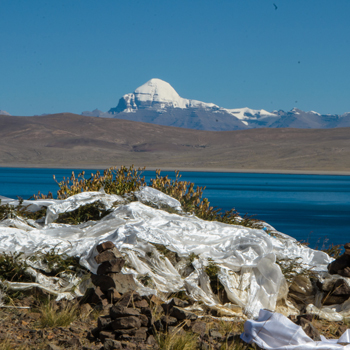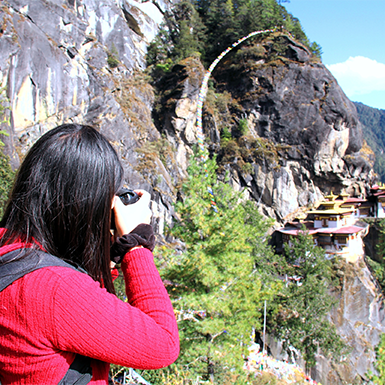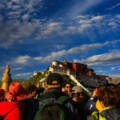The Himalaya Kailash Kora, a revered spiritual hike, attracts pilgrims and adventurers worldwide. This sacred trek around Mount Kailash, known as the Kora around Kailash, holds profound significance in several spiritual traditions. This trip transcends physical exertion, offering a profound spiritual awakening. Participants enjoy stunning landscapes, explore historic monasteries, and have the opportunity to engage in a pilgrimage that traces back centuries.
Mount Kailash, located in the secluded western part of Tibet, is revered as a holy site by Hinduism, Buddhism, Jainism, and Bon followers. In Hinduism, devotees recognize Mount Kailash as Lord Shiva’s dwelling, while Buddhists hold it in high esteem as Buddha Demchok’s residence. Jains revere it as the site where the first Jain Tirthankara achieved nirvana, and Bon followers consider it the center of the universe. The Mount Kailash pilgrimage is a profoundly spiritual experience, uniquely connecting to these ancient traditions.
Highlights of the Kora Trek
- Dolma La Pass: Dolma La Pass is the highest point on the Kora, rising to 5650 meters (18536 feet) and offering breathtaking 360-degree views.
- Lake Manasarovar: A sacred lake considered the source of several rivers and believed to possess healing properties.
- Monasteries: Drirapuk and Zutulupuk monasteries provide opportunities to witness Tibetan Buddhist traditions.
- Prayer flags: Colorful prayer flags wave briskly in the breeze, bearing the hopes and prayers of many pilgrims.
The Historical and Spiritual Significance of Himalaya Kailash and the Kora
Towering over the Himalayas, Mount Kailash isn’t just a peak; it’s a spiritual nexus revered by millions. This guide explores the rich history and spiritual significance of Himalaya Kailash, the Kora, and the circumambulation ritual performed around them.
A Mountain of Faiths
Kailash transcends geographical boundaries, holding deep significance in four major religions:
- Hinduism: Devotees revere Kailash as the eternal abode where Lord Shiva, the destroyer and regenerator, permanently resides with his consort, Parvati.
- Buddhism: For Tibetan Buddhists, Kailash represents Mount Meru, the center of the universe. It’s also believed to be the dwelling place of Demchog, a representation of pure bliss.
- Jainism: Jains revere Kailash as Ashtapada, where their first leader, Rishabhdev, attained enlightenment.
- Bon: The pre-Buddhist Bon religion considers Kailash the abode of the Sky Goddess Sipaimen and the central point of their Tantric rituals.
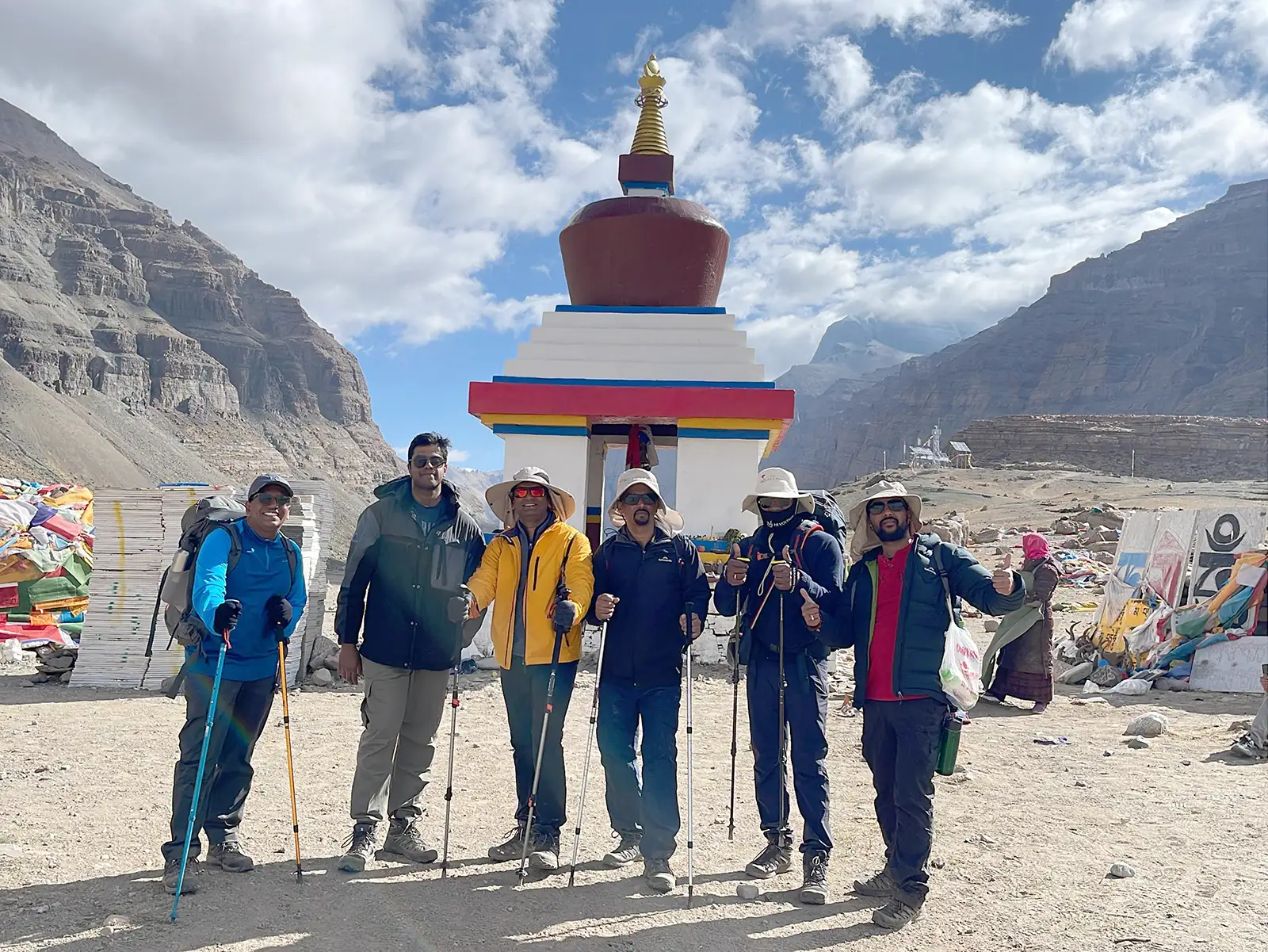
Legends and Myths
Legends abound around Mount Kailash, adding to its mystique:
- Hindu Mythology: The epic Ramayana tells the tale of Ravana, a demon king, attempting to uproot Kailash. Lord Shiva subdued him by pressing his toe on the mountain.
- Buddhist Legend: Milarepa, a famous Tibetan yogi, is said to have flown around Kailash thrice a single night.
The Spiritual Importance of the Kora
The Kora around Mount Kailash is a 52-kilometer pilgrimage thousands undertake each year. Here’s why it holds such spiritual weight:
- Cleansing the Soul: Completing the Kora is believed to purify negative karma and bring good fortune.
- Spiritual Transformation: Many perceive the challenging trek as a metaphor for surmounting obstacles on the trip to enlightenment.
- Connecting with the Divine: The Kora allows pilgrims to connect with the sacred energy believed to emanate from Mount Kailash.
Unveiling the Sacred: Preparing for Your Himalaya Kailash Pilgrimage
The Kora around Kailash, a 52-kilometer spiritual hike, beckons thousands yearly. But before you undertake this once-in-a-lifetime pilgrimage, careful preparation is essential. This guide equips you with the knowledge to ensure a smooth and meaningful Kailash trekking experience.
Choosing the Perfect Time
The Himalaya Kailash region experiences harsh weather conditions. Here’s when to plan your Mount Kailash pilgrimage:
- Spring (April to early June): Enjoy pleasant weather with clear skies and minimal rain.
- Autumn (late September to October): Similar to spring, autumn offers comfortable temperatures with minimal rain chances.
- Summer (July-August): While technically possible, summer brings unpredictable monsoon rains, which can make trekking challenging.
Permits and Documentation
Kailash trekking requires permits due to its remote location. Here’s what you’ll need:
- Tibet Travel Permit: All visitors to Tibet must be part of a pre-arranged tour with a licensed operator like Peregrine Treks and Tours. They handle obtaining this permit.
- Alien’s Travel Permit: Needed for travel outside major cities in Tibet. Peregrine Treks and Tours will typically arrange this as well.
- Military Permit: Peregrine Treks obtains permits to access border areas near Mount Kailash.
- Foreign Affairs Permit: Peregrine facilitates visits to specific regions.
- Passport: Plan your Kailash trek at least six months before your visa expires to ensure it remains valid.
Physical and Mental Preparation
The Kora around Kailash is a high-altitude trek with an average elevation exceeding 4,500 meters. Here’s how to prepare:
- Start Training Early: Begin a physical conditioning program six months beforehand. Focus on building stamina through regular hiking and cardio exercises.
- Acclimatization is Crucial. Before the trek, Consider spending time at a high-altitude location to allow your body to adjust.
- Mind Over Matter: Be prepared for mental challenges. The trek can be demanding, but perseverance is key.
Packing Essentials
Proper gear is vital for a successful Kailash trek. Pack the following:
- Clothing: Pack layered clothing for rapidly changing temperatures, including thermals, waterproof jackets, and comfortable hiking pants.
- Gear: Sturdy hiking boots, trekking poles, sunglasses, sunscreen, and a headlamp are essential.
- Food and Water: Use a reusable water bottle to choose high-calorie, energy-dense snacks and keep hydrated. Experts also recommend taking electrolyte tablets.

The Route and Key Stops of the Kora Around Himalaya Kailash
The Kora around Himalaya Kailash, a once-in-a-lifetime spiritual hike, unfolds over a 52-kilometer (32-mile) route, typically completed in three days. The trail traverses a diverse landscape, offering a chance to connect with nature’s grandeur and profound spiritual significance. Let’s explore the route and its key stops to help you prepare for this transformative experience.
The Kora Route: A Step-by-Step Walk
The traditional Kora route starts and finishes in Darchen, located at the base of Himalaya Kailash. Here’s a breakdown of the key stops along the way:
Darchen: Your starting point is Darchen, a small town with pilgrims and prayer flags. Here, you can visit the Darchen Monastery, a Tibetan Buddhist monastery offering a glimpse into local religious traditions.
Yam Dwar: Leaving Darchen, the trail ascends towards Yam Dwar, meaning “Gate of Death” in Tibetan. This gateway symbolizes the entrance to the sacred realm of Mount Kailash.
Dirapuk Monastery: Nestled amidst a dramatic landscape, Dirapuk Monastery is a popular stop for the first night’s stay. Here, you can experience the tranquility of Tibetan Buddhist life and soak in the stunning mountain views.
Dolma La Pass: Dolma La Pass, the most challenging section of the Kora, reaches its highest point at a staggering 5,650 meters (18,536 feet). The past’s panoramic views are breathtaking, rewarding you for your perseverance.
Zutulphuk Monastery: After descending from the pass, you’ll arrive at Zutulphuk Monastery, another popular overnight stop. This monastery offers a serene atmosphere for reflection and a chance to witness traditional Tibetan prayer rituals.
Scenic Wonders and Spiritual Landmarks
The Kora around Himalaya Kailash isn’t just a physical trek; it’s a spiritual trip. As you travel, you’ll come across numerous scenic highlights and landmarks that enrich the experience:
- Serene High-Altitude Lakes: The trail winds past several beautiful high-altitude lakes, including Gaurikund and Manasarovar Lake. These lakes hold immense spiritual significance for Hindus and Buddhists, as they are believed to possess purifying properties.
- Dramatic Glaciers: Witness the awe-inspiring power of nature as you encounter glaciers clinging to the mountain slopes. These frozen rivers are a stark reminder of the region’s unique ecosystem.
- Colorful Prayer Flags: Throughout the Kora route, vibrant prayer flags flutter in the wind, bearing the hopes and prayers of many pilgrims. These flags add a splash of color to the landscape and serve as a constant reminder of the spiritual significance of the trek.
Exploring the Sacred Tapestry: Cultural Encounters on the Kora Around Himalaya Kailash
The Kora around Himalaya Kailash transcends the physical realm, transforming into a profound cultural experience. As you traverse the path, you’ll have the privilege of interacting with local Tibetan communities and gaining insights into their customs and traditions. This rich cultural tapestry adds another dimension to the Kora’s spiritual significance.
Sharing the Path with Tibetan Communities
The Kora around Himalaya Kailash is a well-trodden path for pilgrims and trekkers. You will meet local Tibetan communities along the entire route. Here’s how you can engage with them respectfully:
- Greetings: A simple “Tashi Delek” (meaning “May good fortune be with you”) goes a long way. Learn basic greetings in Tibetan to show respect for the local culture.
- Monasteries: When you visit monasteries along the route, you can witness traditional Tibetan Buddhist rituals. Be mindful of proper etiquette – dress modestly, avoid disturbing prayer sessions, and ask permission before photographing.
- Local Markets: Darchen, the starting point of the Kora, has small markets where you can purchase Tibetan handicrafts and souvenirs. This interaction boosts the local economy and lets you take home a piece of the culture.
Understanding Local Customs and Traditions
Respecting local customs and traditions ensures a smooth and enriching experience on the Kora. Here are some essential points to remember:
- Respect for Sacred Sites: Tibetans consider Himalaya Kailash and the surrounding areas extremely sacred. Always maintain a respectful demeanor, avoid loud noises, and avoid littering.
- Circumambulation Directions: Always walk the Kora route clockwise, following the path taken by pilgrims for centuries.
- Prayer Wheels and Mani Stones: Along the trail, you’ll encounter prayer wheels and mani stones. Traditionally, pilgrims spin the wheels and touch the stones while reciting mantras. Feel free to participate in this practice if you’d like, but always do so with respect.

The Role of Guides and Porters
Due to the high altitude and challenging terrain, consider hiring a qualified guide for the Kora around Himalaya Kailash. They can offer invaluable assistance with navigation, safety, and cultural understanding.
Sherpa Guides: Sherpas, renowned for their mountaineering expertise, often act as guides on the Kora. Their knowledge of the Himalayas and local customs is invaluable.
Porters: Porters can help carry your backpack, allowing you to focus on the spiritual and physical aspects of the trek.
Unveiling the Inner Strength: Challenges and Rewards of the Kora Around Himalaya Kailash
The Kora around Himalaya Kailash is more than just a walk in the park. It’s a challenging spiritual hike that demands physical and mental resilience. However, the rewards – both spiritual and personal – are genuinely transformative.
Facing the High-Altitude Challenge
The Kora takes place at a high altitude, with the starting point in Darchen sitting at around 4,600 meters (15,000 feet). This situation introduces unique challenges:
- Altitude Sickness: Altitude sickness commonly affects trekkers, causing headaches, nausea, and fatigue. Proper acclimatization is crucial to prevent these issues. Plan to spend a few days in lower altitudes before attempting the Kora.
- Physical Exertion: The trek involves several ascents and descents, which make it physically demanding. Train your cardiovascular system and build stamina beforehand.
Weathering the Elements
The weather conditions around Himalaya Kailash can be unpredictable. Here’s what to expect:
- Sub-Zero Temperatures: Prepare for cold temperatures, especially at night, by packing layers of warm clothing, including thermals, a down jacket, and a good hat.
- Strong Winds: High winds are common, particularly at higher elevations. A sturdy backpack with a rain cover is essential.
- Sudden Downpours: While rain is less frequent, it can occur. Pack a waterproof jacket and waterproof hiking boots.
Triumphing with Spiritual and Personal Rewards
Despite the challenges, completing the Kora around Himalaya Kailash offers profound rewards:
- Spiritual Fulfillment: For many, the Kora is a profoundly spiritual experience. Circumambulating the sacred mountain is believed to cleanse karma, accumulate merit, and bring one closer to enlightenment.
- Sense of Accomplishment: Successfully navigating the challenging terrain fosters a deep understanding of accomplishment and personal growth.
- Inner Reflection: The Kailash Inner Kora provides a unique opportunity for introspection and self-discovery. The beauty of the Himalayas and the quiet solitude of the trail can lead to profound personal insights.
Practical Tips for a Safe and Fulfilling Himalaya Kailash Pilgrimage
The Kora around Himalaya Kailash is a once-in-a-lifetime experience, but meticulous planning is essential for a safe and rewarding spiritual hike. Here, we break down practical tips to address the challenges and ensure a smooth trip:
Conquering Altitude: Essential Acclimatization
- Gradual Ascent: Altitude sickness is a serious concern. Plan to spend at least 2-3 days in Lhasa (3,650 meters) or another lower altitude location before heading to Darchen (4,600 meters). This gradual adjustment allows your body to acclimatize properly.
- Hydration is Key: Even if you aren’t thirsty, drink much water throughout the day. The symptoms of altitude sickness worsen with dehydration.
- Listen to Your Body: Ascend slowly and take frequent rest breaks. If you experience severe headaches, nausea, or dizziness, descend immediately.
Finding Your Pace: Trekking Tips for Success
Slow and Steady Wins the Race: The Kora is more of a marathon than a sprint. To conserve energy, especially during ascents, maintain a slow and steady pace.
Rest Stops are Crucial. Schedule regular rest breaks to catch your breath, enjoy the scenery, and visit teahouses along the route for hydration and snacks.
Proper Hiking Gear: Invest in good quality hiking boots with ankle support, a backpack that fits comfortably, and breathable clothing. Layers are essential for unpredictable weather.
Respecting the Sacred: Cultural Sensitivity and Environmental Awareness
Local Customs: Dress modestly, particularly when visiting monasteries. Avoid loud noises and disrespectful behavior at sacred sites.
Leave No Trace: Pack out all your trash and avoid littering. Minimize your environmental impact by using biodegradable toiletries and respecting the delicate ecosystem.
Support Local Communities: Hire Tibetan guides and porters whenever possible. Buy souvenirs from nearby shops to help the Tibetan economy.
Treading Lightly: Environmental and Ethical Considerations
The Kora around Himalaya Kailash is a sacred pilgrimage attracting thousands yearly. However, with increased tourism comes the responsibility to tread lightly and ensure this special place’s environmental and cultural integrity. Here’s how you can be a responsible Kora trekker:
Sustainable Practices: Leave No Trace
Pack It In, Pack It Out: The Kora route is known for its natural beauty. Preserve it by adhering to Leave No Trace principles. Take out all your garbage, such as leftover food, wrappers, and used toilet paper. Dispose of waste responsibly in designated areas or return it to Darchen for proper disposal.
Minimize Campfire Impact: Campfires may be tempting but can contribute to deforestation. Opt for fuel-efficient camp stoves whenever possible. If campfires are essential, use designated fire rings and collect firewood sustainably, only using dead and fallen wood.
Respect Wildlife: The Kora region has a variety of fauna. Keep a safe distance from animals and do not interfere with their natural environment. Avoid feeding wild animals since it may disturb their normal behavior.
Ethical Considerations: Supporting Local Communities
Responsible Hiring: Consider hiring Tibetan guides and porters for the Kora. Their knowledge of the terrain and customs is invaluable, and your support directly benefits the local economy.
Choose Eco-Friendly Lodges: Opt for guesthouses and lodges that prioritize sustainability practices. Look for those that use local resources, minimize waste, and support renewable energy sources.
Respectful Shopping: If you purchase souvenirs from local vendors who create traditional handicrafts. Avoid items made from endangered wildlife or that exploit local artisans.
Conclusion
The Kora around Himalaya Kailash is more than just a trek; it’s a transformative experience transcending the physical realm. This spiritual hike, a pilgrimage undertaken by followers of various religions, offers breathtaking landscapes, profound cultural encounters, and the chance to connect with your inner self.
A Journey of Spirit and Endurance
Completing the Kora is challenging but rewarding. The 52-kilometer route traverses high altitudes, demanding physical resilience and proper acclimatization. However, the rewards outweigh the challenges. Witnessing the majestic Mount Kailash, encountering vibrant Tibetan culture, and experiencing the tranquility of the Himalayas fosters a deep sense of peace and accomplishment.
A Call to the Soul
The Kora around Himalaya Kailash beckons those seeking a unique spiritual adventure. Whether you’re a seasoned trekker or a spiritual explorer, this pilgrimage offers an opportunity for reflection, personal growth, and a deeper connection to something greater than yourself.
Is the Kora Right for You?
Carefully consider your physical capabilities and spiritual aspirations before undertaking the Kora. The Kora awaits if you are up for the challenge and yearn for a transformative experience. Following the practical tips outlined in this guide can ensure a safe and fulfilling trip on this sacred path.
